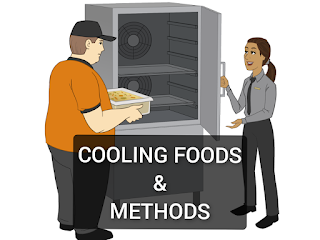Cooling guidelines
- Food should be cooled as quickly as possible.
- The temperature at the centre of the food product should be reduced from 63'C (145F) to 21°C (70°F) in less than two hours; and from 21°C (70°F) to 5°C:(41°F) or less within 4 hours.
Cooling methods
The following methods may be used to cool foods rapidly:
- placing the food in shallow pan,
- separating the food Into smaller or thinner portions;
- using rapid cooling equipment, such as 'blast chillers'
- stirring the food in a container placed in an ice bath;
- placing the food in containers that facilitate the rapid trarnsfer of heat;
- adding ice as an ingredient to the food;
- cooling food containers or food under running cold potable water;
- storing the food in a cool designated area;
- placing the food In pre-frozen or cold containers;
- using a combination of the methods described above.
Q&A
What are the 3 methods for cooling food?
Approved methods to cool food
Ice-water bath and frequently stirring the food. ...
Ice paddles (plastic container filled with water and frozen) used to stir food in an ice-water bath.
Adding ice as an ingredient (if water is an ingredient).
What is the safest way to cool food?
Cover pans of hot food and move them to a colder area e.g. a storage room, or stand them in cold water. You can also use ice to speed up chilling. This will make the contents of the pans chill more quickly. Stir food regularly while it is chilling down. or tumble chiller.
Why is it important to chill food?
Chilling food properly helps stop harmful bacteria from growing. To keep your food safe: store any food with a 'use by' date, along with cooked dishes, salads and dairy products, in your fridge. keep chilled food out of the fridge for the shortest time possible during preparation.
Can I put warm cooked food in the fridge?
I wouldn't put hot cooked food directly into the fridge, though, as it will raise the temperature of your fridge. Let it cool for a little while, maybe even let it sit on some ice, then refrigerate. You can re-heat it all at once, in a low temperature (250°F or so) oven, or cut into individual servings and microwave it.
Is putting hot food in the freezer bad?
Under no circumstances should you ever put something that's still hot, or even warm, in your freezer. For one, it will heat up your freezer and possibly thaw out items around it which is very unsafe. Secondly, it will take forever to freeze something that's hot which could lead to a bacteria breeding ground.
What temperature kills bacteria in food?
165 degrees
In fact, bacteria growth is slowed, but not stopped. The only way to kill bacteria by temperature is by cooking food at temperatures of 165 degrees or more. Bacteria also die in highly acidic environments like pickle juice.
Which method of cooking destroys the most bacteria?
Boiling does kill any bacteria active at the time, including E. coli and salmonella.
Can rapid freezing destroy food poisoning bacteria?
False: Bacteria can survive freezing temperatures. Freezing is not a method for making food safe to eat. When food is thawed, bacteria can still be present and may begin to multiply. Cooking food to the proper internal temperature is the best way to kill harmful bacteria.
Where is the safest place to defrost meat?
the refrigerator
When thawing frozen food, it's best to plan ahead and thaw in the refrigerator where it will remain at a safe, constant temperature — at 40 °F or below. There are three safe ways to thaw food: in the refrigerator, in cold water, and in the microwave.











0 comments:
Post a Comment